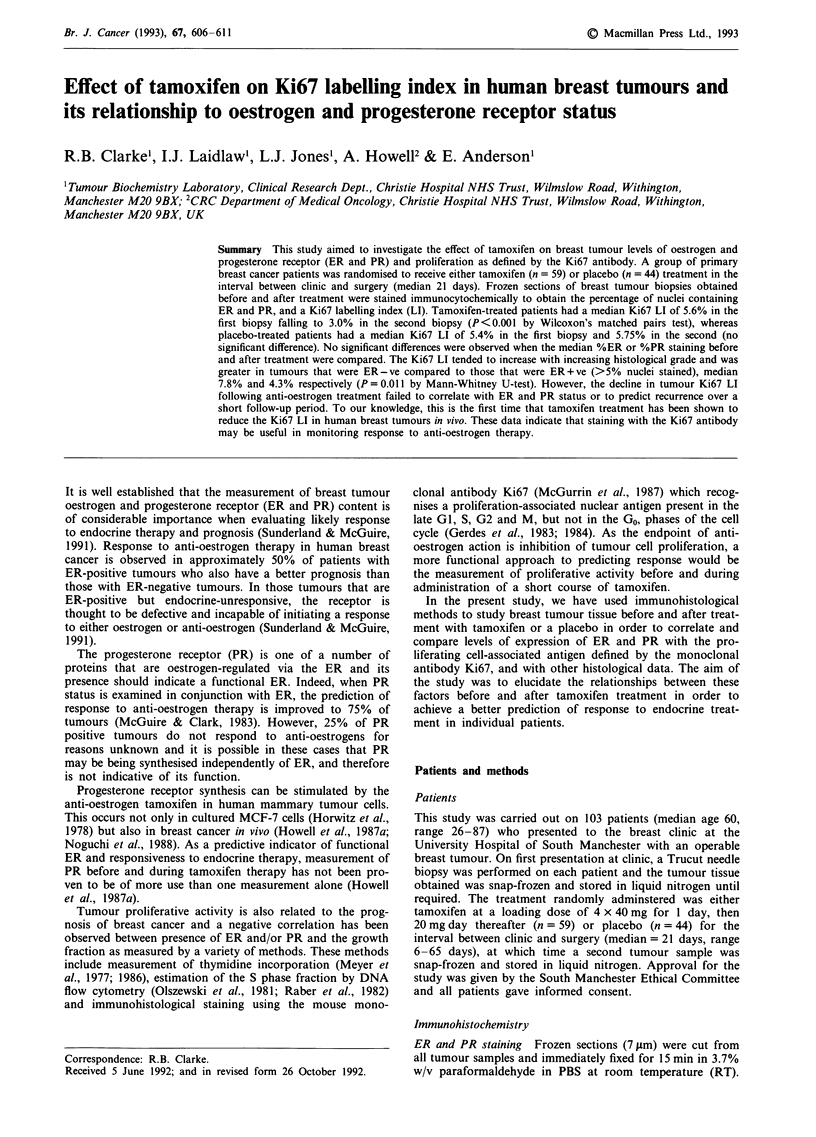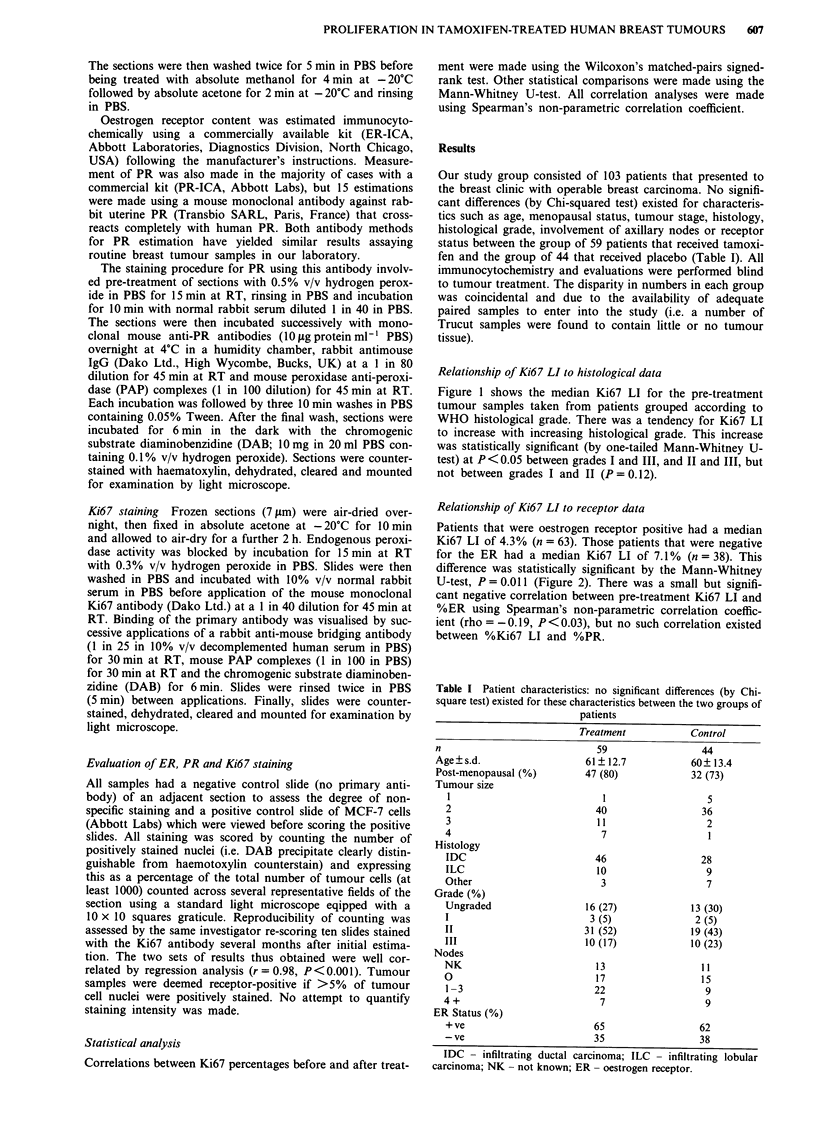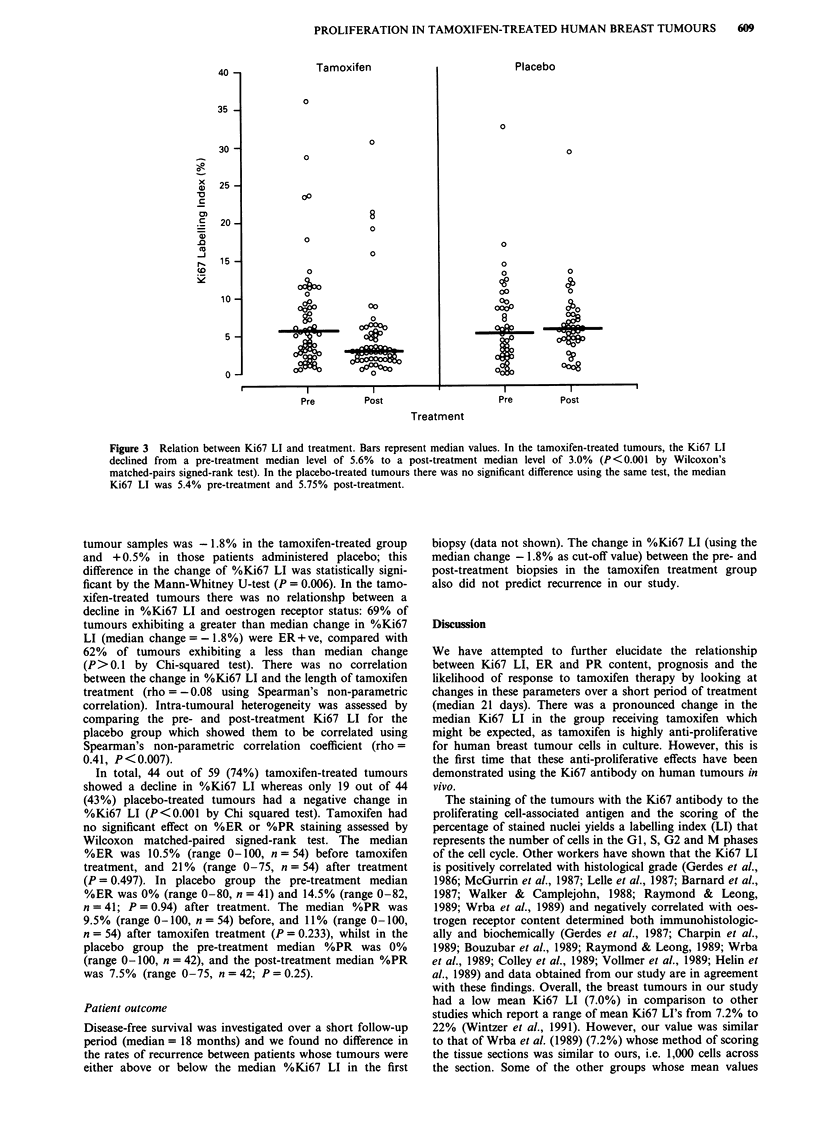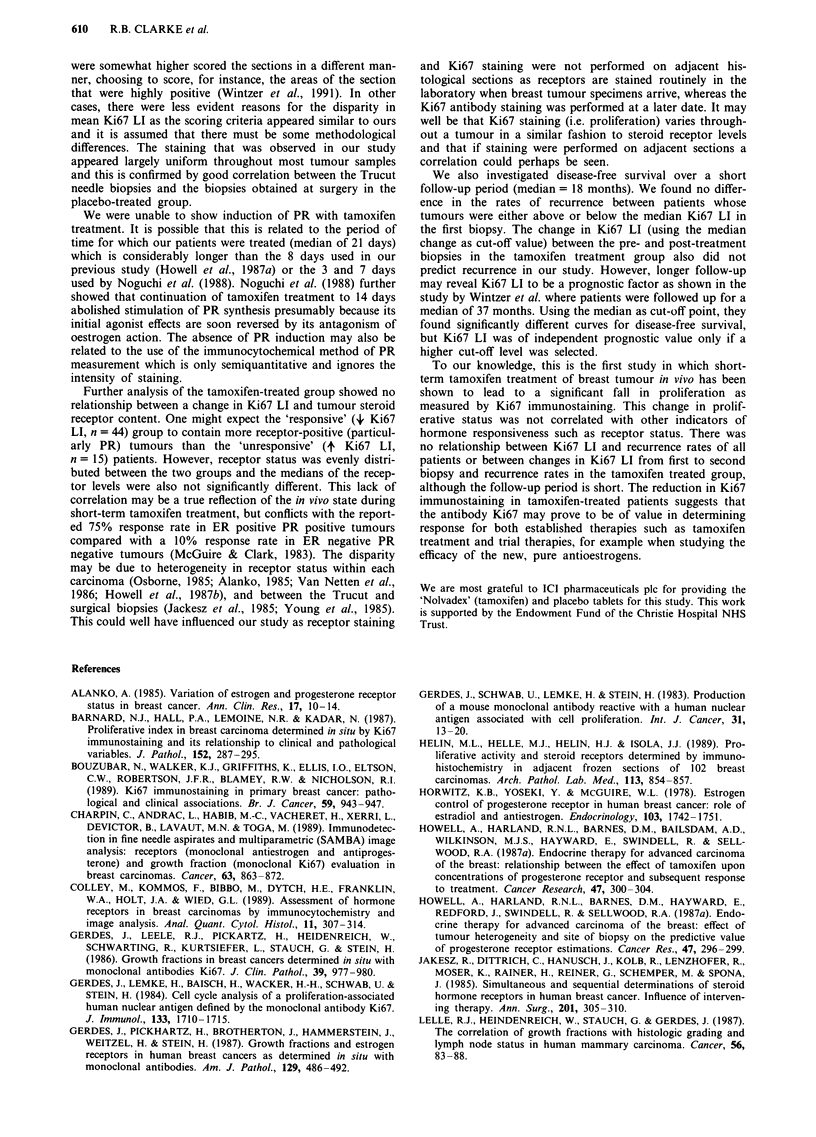Abstract
This study aimed to investigate the effect of tamoxifen on breast tumour levels of oestrogen and progesterone receptor (ER and PR) and proliferation as defined by the Ki67 antibody. A group of primary breast cancer patients was randomised to receive either tamoxifen (n = 59) or placebo (n = 44) treatment in the interval between clinic and surgery (median 21 days). Frozen sections of breast tumour biopsies obtained before and after treatment were stained immunocytochemically to obtain the percentage of nuclei containing ER and PR, and a Ki67 labelling index (LI). Tamoxifen-treated patients had a median Ki67 LI of 5.6% in the first biopsy falling to 3.0% in the second biopsy (P < 0.001 by Wilcoxon's matched pairs test), whereas placebo-treated patients had a median Ki67 LI of 5.4% in the first biopsy and 5.75% in the second (no significant difference). No significant differences were observed when the median %ER or %PR staining before and after treatment were compared. The Ki67 LI tended to increase with increasing histological grade and was greater in tumours that were ER - ve compared to those that were ER + ve (> 5% nuclei stained), median 7.8% and 4.3% respectively (P = 0.011 by Mann-Whitney U-test). However, the decline in tumour Ki67 LI following anti-oestrogen treatment failed to correlate with ER and PR status or to predict recurrence over a short follow-up period. To our knowledge, this is the first time that tamoxifen treatment has been shown to reduce the Ki67 LI in human breast tumours in vivo. These data indicate that staining with the Ki67 antibody may be useful in monitoring response to anti-oestrogen therapy.
Full text
PDF





Selected References
These references are in PubMed. This may not be the complete list of references from this article.
- Alanko A. Variation of estrogen and progesterone receptor status in breast cancer. Ann Clin Res. 1985;17(1):10–14. [PubMed] [Google Scholar]
- Barnard N. J., Hall P. A., Lemoine N. R., Kadar N. Proliferative index in breast carcinoma determined in situ by Ki67 immunostaining and its relationship to clinical and pathological variables. J Pathol. 1987 Aug;152(4):287–295. doi: 10.1002/path.1711520407. [DOI] [PubMed] [Google Scholar]
- Bouzubar N., Walker K. J., Griffiths K., Ellis I. O., Elston C. W., Robertson J. F., Blamey R. W., Nicholson R. I. Ki67 immunostaining in primary breast cancer: pathological and clinical associations. Br J Cancer. 1989 Jun;59(6):943–947. doi: 10.1038/bjc.1989.200. [DOI] [PMC free article] [PubMed] [Google Scholar]
- Charpin C., Andrac L., Habib M. C., Vacheret H., Xerri L., Devictor B., Lavaut M. N., Toga M. Immunodetection in fine-needle aspirates and multiparametric (SAMBA) image analysis. Receptors (monoclonal antiestrogen and antiprogesterone) and growth fraction (monoclonal Ki67) evaluation in breast carcinomas. Cancer. 1989 Mar 1;63(5):863–872. doi: 10.1002/1097-0142(19890301)63:5<863::aid-cncr2820630512>3.0.co;2-p. [DOI] [PubMed] [Google Scholar]
- Colley M., Kommoss F., Bibbo M., Dytch H. E., Franklin W. A., Holt J. A., Wied G. L. Assessment of hormone receptors in breast carcinoma by immunocytochemistry and image analysis. II. Estrogen receptors. Anal Quant Cytol Histol. 1989 Oct;11(5):307–314. [PubMed] [Google Scholar]
- Gerdes J., Lelle R. J., Pickartz H., Heidenreich W., Schwarting R., Kurtsiefer L., Stauch G., Stein H. Growth fractions in breast cancers determined in situ with monoclonal antibody Ki-67. J Clin Pathol. 1986 Sep;39(9):977–980. doi: 10.1136/jcp.39.9.977. [DOI] [PMC free article] [PubMed] [Google Scholar]
- Gerdes J., Lemke H., Baisch H., Wacker H. H., Schwab U., Stein H. Cell cycle analysis of a cell proliferation-associated human nuclear antigen defined by the monoclonal antibody Ki-67. J Immunol. 1984 Oct;133(4):1710–1715. [PubMed] [Google Scholar]
- Gerdes J., Pickartz H., Brotherton J., Hammerstein J., Weitzel H., Stein H. Growth fractions and estrogen receptors in human breast cancers as determined in situ with monoclonal antibodies. Am J Pathol. 1987 Dec;129(3):486–492. [PMC free article] [PubMed] [Google Scholar]
- Gerdes J., Schwab U., Lemke H., Stein H. Production of a mouse monoclonal antibody reactive with a human nuclear antigen associated with cell proliferation. Int J Cancer. 1983 Jan 15;31(1):13–20. doi: 10.1002/ijc.2910310104. [DOI] [PubMed] [Google Scholar]
- Helin M. L., Helle M. J., Helin H. J., Isola J. J. Proliferative activity and steroid receptors determined by immunohistochemistry in adjacent frozen sections of 102 breast carcinomas. Arch Pathol Lab Med. 1989 Aug;113(8):854–857. [PubMed] [Google Scholar]
- Horwitz K. B., Koseki Y., McGuire W. L. Estrogen control of progesterone receptor in human breast cancer: role of estradiol and antiestrogen. Endocrinology. 1978 Nov;103(5):1742–1751. doi: 10.1210/endo-103-5-1742. [DOI] [PubMed] [Google Scholar]
- Howell A., Harland R. N., Barnes D. M., Baildam A. D., Wilkinson M. J., Hayward E., Swindell R., Sellwood R. A. Endocrine therapy for advanced carcinoma of the breast: relationship between the effect of tamoxifen upon concentrations of progesterone receptor and subsequent response to treatment. Cancer Res. 1987 Jan 1;47(1):300–304. [PubMed] [Google Scholar]
- Howell A., Harland R. N., Barnes D. M., Hayward E., Redford J., Swindell R., Sellwood R. A. Endocrine therapy for advanced carcinoma of the breast: effect of tumor heterogeneity and site of biopsy on the predictive value of progesterone receptor estimations. Cancer Res. 1987 Jan 1;47(1):296–299. [PubMed] [Google Scholar]
- Jakesz R., Dittrich C., Hanusch J., Kolb R., Lenzhofer R., Moser K., Rainer H., Reiner G., Schemper M., Spona J. Simultaneous and sequential determinations of steroid hormone receptors in human breast cancer. Influence of intervening therapy. Ann Surg. 1985 Mar;201(3):305–310. doi: 10.1097/00000658-198503000-00008. [DOI] [PMC free article] [PubMed] [Google Scholar]
- Lellé R. J., Heidenreich W., Stauch G., Gerdes J. The correlation of growth fractions with histologic grading and lymph node status in human mammary carcinoma. Cancer. 1987 Jan 1;59(1):83–88. doi: 10.1002/1097-0142(19870101)59:1<83::aid-cncr2820590119>3.0.co;2-i. [DOI] [PubMed] [Google Scholar]
- McGuire W. L., Clark G. M. The prognostic role of progesterone receptors in human breast cancer. Semin Oncol. 1983 Dec;10(4 Suppl 4):2–6. [PubMed] [Google Scholar]
- McGurrin J. F., Doria M. I., Jr, Dawson P. J., Karrison T., Stein H. O., Franklin W. A. Assessment of tumor cell kinetics by immunohistochemistry in carcinoma of breast. Cancer. 1987 May 15;59(10):1744–1750. doi: 10.1002/1097-0142(19870515)59:10<1744::aid-cncr2820591012>3.0.co;2-d. [DOI] [PubMed] [Google Scholar]
- Meyer J. S., Prey M. U., Babcock D. S., McDivitt R. W. Breast carcinoma cell kinetics, morphology, stage, and host characteristics. A thymidine labeling study. Lab Invest. 1986 Jan;54(1):41–51. [PubMed] [Google Scholar]
- Meyer J. S., Rao B. R., Stevens S. C., White W. L. Low incidence of estrogen receptor in breast carcinomas with rapid rates of cellular replication. Cancer. 1977 Nov;40(5):2290–2298. doi: 10.1002/1097-0142(197711)40:5<2290::aid-cncr2820400541>3.0.co;2-t. [DOI] [PubMed] [Google Scholar]
- Noguchi S., Miyauchi K., Nishizawa Y., Koyama H. Induction of progesterone receptor with tamoxifen in human breast cancer with special reference to its behavior over time. Cancer. 1988 Apr 1;61(7):1345–1349. doi: 10.1002/1097-0142(19880401)61:7<1345::aid-cncr2820610712>3.0.co;2-j. [DOI] [PubMed] [Google Scholar]
- Olszewski W., Darzynkiewicz Z., Rosen P. P., Schwartz M. K., Melamed M. R. Flow cytometry of breast carcinoma: II. Relation of tumor cell cycle distribution to histology and estrogen receptor. Cancer. 1981 Aug 15;48(4):985–988. doi: 10.1002/1097-0142(19810815)48:4<985::aid-cncr2820480422>3.0.co;2-q. [DOI] [PubMed] [Google Scholar]
- Osborne C. K. Heterogeneity in hormone receptor status in primary and metastatic breast cancer. Semin Oncol. 1985 Sep;12(3):317–326. [PubMed] [Google Scholar]
- Raber M. N., Barlogie B., Latreille J., Bedrossian C., Fritsche H., Blumenschein G. Ploidy, proliferative activity and estrogen receptor content in human breast cancer. Cytometry. 1982 Jul;3(1):36–41. doi: 10.1002/cyto.990030109. [DOI] [PubMed] [Google Scholar]
- Raymond W. A., Leong A. S. The relationship between growth fractions and oestrogen receptors in human breast carcinoma, as determined by immunohistochemical staining. J Pathol. 1989 Jul;158(3):203–211. doi: 10.1002/path.1711580306. [DOI] [PubMed] [Google Scholar]
- Vollmer G., Gerdes J., Knuppen R. Relationship of cytosolic estrogen and progesterone receptor content and the growth fraction in human mammary carcinomas. Cancer Res. 1989 Jul 15;49(14):4011–4014. [PubMed] [Google Scholar]
- Walker R. A., Camplejohn R. S. Comparison of monoclonal antibody Ki-67 reactivity with grade and DNA flow cytometry of breast carcinomas. Br J Cancer. 1988 Mar;57(3):281–283. doi: 10.1038/bjc.1988.60. [DOI] [PMC free article] [PubMed] [Google Scholar]
- Wintzer H. O., Zipfel I., Schulte-Mönting J., Hellerich U., von Kleist S. Ki-67 immunostaining in human breast tumors and its relationship to prognosis. Cancer. 1991 Jan 15;67(2):421–428. doi: 10.1002/1097-0142(19910115)67:2<421::aid-cncr2820670217>3.0.co;2-q. [DOI] [PubMed] [Google Scholar]
- Wrba F., Chott A., Reiner A., Reiner G., Markis-Ritzinger E., Holzner J. H. Ki-67 immunoreactivity in breast carcinomas in relation to transferrin receptor expression, estrogen receptor status and morphological criteria. An immunohistochemical study. Oncology. 1989;46(4):255–259. doi: 10.1159/000226727. [DOI] [PubMed] [Google Scholar]
- Young S. C., Burkett R. J., Stewart C. Discrepancy in ER levels of breast carcinoma in biopsy vs mastectomy specimens. J Surg Oncol. 1985 May;29(1):54–56. doi: 10.1002/jso.2930290116. [DOI] [PubMed] [Google Scholar]
- van Netten J. P., Coy P., Brigden M. L., Gallagher S., Carlyle S. J., Thornton I. Intermediate estrogen receptor levels in breast cancer. Eur J Cancer Clin Oncol. 1986 Dec;22(12):1543–1545. doi: 10.1016/0277-5379(86)90095-7. [DOI] [PubMed] [Google Scholar]


